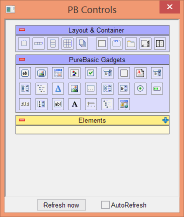once one get used to the the XML-Dialog Commands, they become really handy.
Especially when you design Apps with changeable Window-Size.
But I have 2 little requests:
1. Would it be possible, to add an option, to ignore the width/height of an invisible Gadget during your calculation for the dialog dimensions?
e.g.: In a program are several container which the user can fold (hide/unhide) by clicking a Button.
If you just hide them via HideGadget(), the dimension of the hidden Gadgets are still included in the RefreshDialog() calculation and the region just stays blank.
In an automatic Gadgetposition-Arrangement - like the XML-Dialog does, it would be great if it cloud ignore invisible gadgets and rearrange the visible Gadgets as if the invisible Gadgets are just not there.
As an example, you may have a look at THIS part of a XML-Dialog Designer I'm working on right now. You could fold/unfold the Container by clicking the (-/+) Buttons on the left side of the Headers.

To realize this fold/unfold feature, I have to close the whole dialog and reopen it with a changed XML-Code (without the tags for the container and all of it's gadgets).
As you can see, this results in an unpleasant Window-Close / Window-Open.
If the size of an invisible Gadget will be calculated as zero, a HideGadget() and RefreshDialog() would do the job.
2. GridBox - change number of columns after Dialog has been opened
As you can also see in the example from above, I change the number of displayed icons in a row when the user changes the width of the window.
To do so, I just have to change the number of columns in the <GridBox>.
But again ... one has to close the dialog, change the number of columns in the XML-Code and reopens the Dialog - which results in this Window-Olose / Window-Open effect again.
Would it be possible to implement an option to change the number of columns (or even other Parameters of the XML-Layout Elements) after creating the Dialog?
2.1 Maybe you could provide us with an insight into your Dialog-Structure, so the (experienced) user would be able to add/remove Gadgets 'on the fly'
E.g.: In the Dialog-Designer example from above - the user could add/remove Gadgets to the Emelent-List.
So far I don't see a way to realize this, without closing the Dialog, adding the new Elements to the XML.Code and reopening the whole Dialog again.
Adding new Elements (Gadgets) to the Element-Container 'on the fly' using the PB-Gadgets-Commands isn't the problem, but (so far) these new Gadgets will not be recognized by your Dialog-Routines and therefore they will not be handled by them.
Thanks a lot for all of your great work,
Albert.



